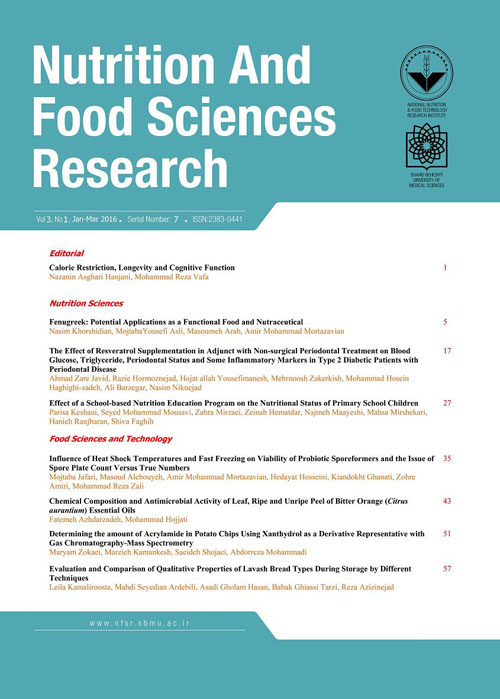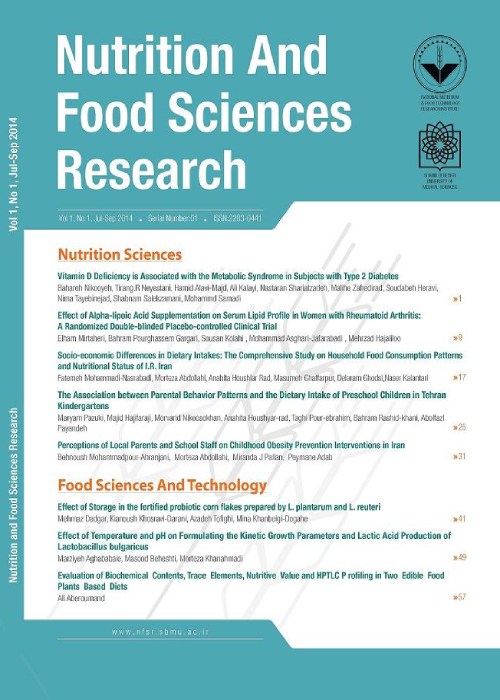فهرست مطالب

Nutrition & Food Technology Research
Volume:3 Issue: 1, Jan-Mar 2016
- تاریخ انتشار: 1394/12/01
- تعداد عناوین: 8
-
-
Pages 5-16Fenugreek (Trigonella foenum graecum), native to southern Europe and Asia, is an annual herb with white flowers and hard, yellowish brown and angular seeds, known from ancient times, for nutritional value beside of its medicinal effects. Fenugreek seeds are rich source of gum, fiber, alkaloids, flavonoids, saponins and volatile content. Due to its high content of fiber, fenugreek could be used as food stabilizer, adhesive and emulsifying agent to change food texture for some special purposes. Some evidence suggests that fenugreek may also be regarded as antidiabetic, anticarcinogenic, antioxidant, antibacterial agent, antianorexia agent, and gastric stimulant, as well as remedy for hypocholesterolemia and hypoglycemia. The present article is aimed to review the potential applications of fenugreek as a functional food and nutraceutical agent.Keywords: Chemical composition, Fenugreek gum, Fenugreek, Health benefits
-
Pages 17-26Background And ObjectivesDiabetes mellitus and periodontal disease are two chronic and common diseases with close relationship together affecting public health and quality of life. The aim of this study was to investigate the effect of resveratrol supplementation in adjunct with non-surgical periodontal treatment (NST) on blood glucose, triglyceride, periodontal status and inflammatory markers in type 2 diabetic patients with periodontal disease.Materials And MethodsThis double-blind clinical trial study was conducted on 43 diabetic patients with periodontitis referred to the Endocrinology Clinic at Golestan Hospital in Ahvaz, Iran. All subjects were randomly assigned into two groups of intervention and control. The intervention and control groups received either 480 mg/d resveratrol or placebo capsules (2 PCs) for four weeks. All subjects underwent non-surgical periodontal therapy during the intervention period. Anthropometric parameters, 24-hour dietary recall, fasting blood sugar, insulin, insulin resistance (HOMA-IR), triglycerides, pocket depth (PD), IL6 and TNF&alpha were evaluated in all subjects pre- and post-intervention.ResultsThe mean serum levels of fasting insulin and insulin resistance (HOMA-IR) were significantly (P=0.02, P=0.045, respectively) lower in the intervention group compared with the control group (10.42 ± 0.28 and 10.92 ± 0.9 3.66 ± 0.97 and 4.49 ± 1.56, respectively). Moreover, significant difference (P < 0.001) was obtained in the mean pocket depth (PD) between the intervention and control groups (2.35 ± 0.6 and 3.38 ± 0.5, respectively) post-intervention. In the intervention group, the mean serum level of IL6 was reduced significantly (P= 0.039) post-intervention (1.58 ± 1.06 and 2.19± 1.09). No significant differences were seen in the mean levels of fasting blood sugar, triglycerides, IL6 and TNF&alpha between the two groups post-intervention.ConclusionsIt is suggested that resveratrol may be recommended as adjuvant therapy along with non-surgical periodontal treatment in diabetic patients with periodontal disease.Keywords: Type 2 diabetes mellitus_Periodontal disease_Resveratrol_Insulin resistance_Inflammatory markers
-
Pages 27-34Background And ObjectivesRegarding the high prevalence of unhealthy food habits among Iranian children, we aimed to assess the effect of a school-based nutrition education program on nutritional status of primary school students in Shiraz.Materials And MethodsThis randomized educational controlled trial was carried out on 221 primary school age children selected by cluster sampling in the elementary schools of Shiraz-Iran. The intervention consisted of 6 nutrition education sessions carried out through one year for children, using active learning methods. Mothers’ education was carried out in person in both lecture and question-answer sessions also via sending text messages and pamphlets. Weight, height and waist circumference (WC) of children were measured before and after the intervention. Also a 168-item food frequency questionnaire was completed. Two separate nutrition knowledge questionnaires were filled up by children and their mothers. Data were analyzed using SPSS version 16.Results171 children (83 in the case and 88 in the control group), aged 9.5-10.5 years, completed the study. Anthropometric and nutritional knowledge of the participants in both the intervention and control groups was significantly increased. Weight, height, WC and nutritional knowledge increased significantly more in the intervention group compared to the controls. Consumption of fruits and vegetables decreased in the intervention group while plain sugar and fast foods intake increased among the controls. There were no significant differences between the changes in the intake of any of the food groups in the two groups.ConclusionsIn conclusion, the designed nutrition education program could increase students’ nutritional knowledge, and lead to a non-significant change towards reducing the consumption of unhealthy foods such as fast foods, sweets and salty snacks.Keywords: Nutrition education, Nutritional status, Children
-
Pages 35-42Background And ObjectivesThe purpose of the present study was to investigate effects of various heat shock conditions and fast freezing and subsequent thawing on the viability and recovery of Bacillus coagulans and Bacillus subtilis as probiotic sporeformers, and also to compare spore plate and microscopic counts.Materials And MethodsAfter preparing the final suspensions of B. coagulans and Bacillus subtilis subsp. Natto spores, they were spread-plated before and after fast freezing treatment (-70°C for about 1 min). Heat shock treatments of the spores were carried out at 68oC for 15, 20, and 30 min as well as at 80oC for 10 and 15 min. Concentrations of the examined probiotic sporeformers were determined simultaneously by plate enumerations and microscopically determined counts. Student’s t-test and one-way analysis of variance (ANOVA) of SPSS were used for statistical analysis of the data. Analysis of DoE results was carried out using Minitab.ResultsThe results presented here show that the highest recovery rates for B. coagulans (14.75 log CFU/mL) and B. subtilis spores (14.80 log CFU/mL) were under a heat shock condition of 68°C for 20 min in nutrient agar (p<0.05). In addition, the survival rates of B. coagulans and B. subtilis spores under the fast freezing and subsequent thawing condition were about 90% and 88%, respectively. Plate counts differed significantly from counts determined microscopically, with differences of almost 0.5 and 0.8 log for B. coagulans and B. subtilis spores, respectively (p<0.05). In addition, DoE results of the study revealed that both factors of spore count method and only freezing factor in fast freezing treatment have a significant effect on concentrations of the spores examined (p<0.05).ConclusionsHeat shock conditions, freezing and subsequent thawing circumstances, and plate counts or enumerations determined microscopically have significant influences on the viability of probiotic sporeformers and should be considered in determining of their accurate concentrations.Keywords: B. coagulans, B. subtilis, Freezing, Heat shock, Probiotic sporeformers
-
Pages 43-50Background And ObjectivesThe chemical composition and antimicrobial activity of bitter orange (Citrus aurantium) leaf, ripe and unripe peel essential oils, cultivated in southwest of Iran, were investigated.Materials And MethodsThe analysis of chemical composition of hydro-distilled essential oils was carried out by GC-MS. The disc diffusion and broth micro-dilution were used to assay the antimicrobial effect of achieved essential oils.ResultsAccording to the GC-MS analysis, 34, 39 and 21 components were determined in the leaf, ripe and unripe peel, respectively. The results revealed that the main components of all essential oils were linalool and limonene. The oxygenated monoterpene and hydrocarbonated monoterpene were the main chemical groups of leaf and peel essential oils, respectively. Although all of the examined essential oils had antimicrobial potential, the leaf and unripe peel essential oils with MIC of 4.67 mg/ml were the most effective against the bacteria and yeast species, respectively, and the ripe peel essential oil was the weakest one. The growth of Saccharomyces cerevisiae was controlled in the treated orange juices. The antifungal activity of essential oils was increased by rising up in their concentration and decreased by passing time. Unripe and ripe essential oils showed the strongest and weakest anti yeast potential, respectively.ConclusionsThe essential oils of leaves and ripe and unripe peels of bitter orange could be used as natural preservatives in food industry.Keywords: Citrus aurantium, Antimicrobial, Antioxidant, Essential oil, GC, MS
-
Pages 51-56Background And ObjectivesIn the production process of foods rich in carbohydrates and some other foods containing precursors of acrylamide formation, there is the possibility of acrylamide creation, which is a mutagen and carcinogen material. This study aims to introduce and optimize a new method for determining acrylamide in potato chips using xanthydrol as a derivative representative with gas chromatography-mass spectrometry.Materials And MethodsImportant factors in the derivatization and measurement processes were optimized using the one-factor-at-a-time method. The peak areas were assumed as the GC-MS response to evaluate the extraction efficiency of acrylamide, and optimization for all tests was performed two times. Figures of merit of the proposed method were evaluated. The amount of acrylamide in four potato chips samples, obtained from the market in Tehran city, was determined using the proposed method.ResultsThe optimum amounts of effective parameters, including derivatization temperature at 25oC, derivatization time (40 min), xanthydrol volume (40 µL), extracted solvent volume (500 µL) and pH=7 were determined. The figures of merit for the proposed method were at the ideal range. The maximum and minimum amounts of acrylamide in the chip samples were also measured.ConclusionsThe performance and reliability of proposed method as a simple, efficient and rapid method for determining acrylamide in potato chip samples were demonstrated.Keywords: Potato chips, Acrylamide, Xanthydrol, Gas Chromatography, Mass Spectrometry
-
Pages 57-70Background And ObjectiveThe quality of flat breads depends in part on the textural and structural properties of breads during storage. These properties are largely affected by flour quality. This research aimed at evaluating textural and structural properties of Lavash bread types during storage by different techniques, comparing these methods and determination of correlation between their results.Materials And MethodsThree Lavash flours (named strong, medium and weak flours) with different physical, chemical and rheological properties were performed. Determination of texture hardness of Lavash breads (Lavash A, Lavash B and Lavash C made of strong, medium and weak flours respectively) during storage carried out by Texture analyzer, evaluation of breads porosity and their changes process during storage performed by ultrasonic nondestructive technique, assessment of breads microstructure made by SEM, evaluation of starch gelatinization and retro gradation performed by DSC and the sensory evaluation of breads made by trained panelist.ResultsLavash B made from medium flour had less hardness, lower transition of ultrasonic wave velocity and less values of elastic modulus, reduced values of enthalpy and lower average of temperatures, more pores diameter and area of images and higher points of sensory evaluation than Lavash A and Lavash C breads during storage time. The results of mentioned tests (devices and sensory tests) had significant correlation to each other.ConclusionDesirable quality characterization and higher shelf life of Lavash B was due to flour qualitative characteristics of this type of bread to obtain dough with appropriate elasticity and excellent sheeting capability. Ultrasonic non-destructive method is recommended to use instead of other methods for assessing texture, cell structure and elastic properties of bread after baking and during storage time. This method is fast, non-destructive and cheaper than other methods and can be used during production.Keywords: Lavash Bread, Quality, Retro gradation, Stalling


